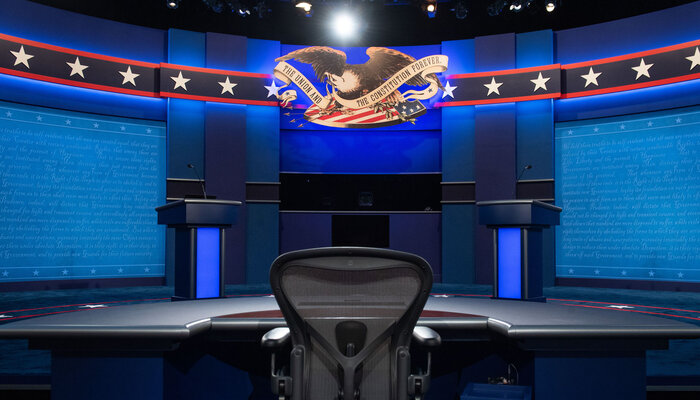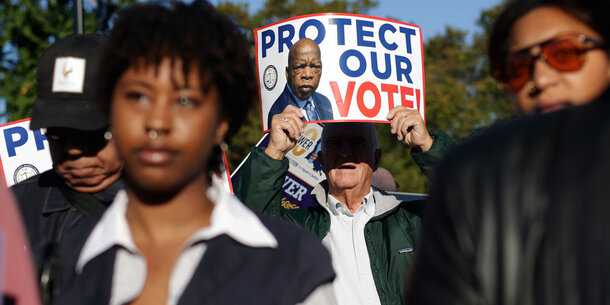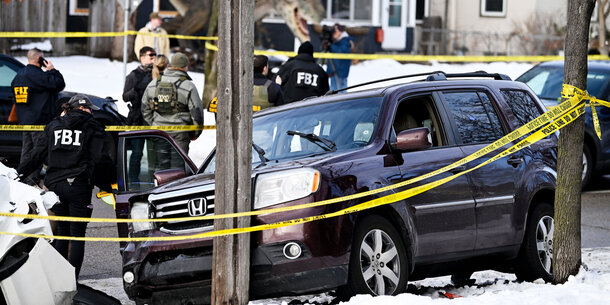In April, the Republican National Committee voted unanimously to bar the party’s 2024 presidential nominee from appearing in any events sponsored by the nonpartisan Commission on Presidential Debates. Republican National Committee (RNC) Chair Ronna McDaniel issued a blistering statement calling the debate commission “biased.”
It did not require much detective work to see this preventive strike as the revenge of Donald Trump, who scuffled with the debate commission all through the fall 2020 campaign. As Washington Post columnist Paul Waldman noted, “A core part of Trump’s worldview, which has now been assimilated throughout the GOP, is that only procedures and processes biased in his favor are truly fair.” David Frum, writing in The Atlantic, made an analogous point, noting the only way to satisfy Trump’s supporters “is to just let Trump interview himself for 90 minutes, to be followed by a panel applauding Trump and ridiculing his rival.
Most of the commentary surrounding the RNC’s vote mourned the decision as another example of the erosion of democratic norms. John Hudak, a senior fellow at the Brookings Institution, pointed out, “Presidential debates are the only opportunity for candidates to face off directly and, as such, are an important part of our democratic process.”
In response to this common lament, it is tempting to reflexively come to the defense of the Commission, which replaced the League of Women Voters as the debate sponsor beginning with the 1988 presidential election. But the truth is that even before Trump, the traditional fall presidential debates had lost their luster. A 2015 study from the University of Pennsylvania’s Annenberg Public Policy Center concluded that “the general format had calcified” and noted that during the prior two decades, “innovation had largely stopped.”
Whether these interparty face-offs continue in 2024 or resume in 2028, major changes are needed in the debate format to better educate voters and enhance democracy.
The Problem with the Debate Format
A case can be made that from the beginning — with the famed John Kennedy-Richard Nixon encounters in 1960 — the presidential debate format was flawed. The dominant topic following that first debate was not the quality of the candidates’ responses but Nixon’s five-o’clock shadow and gaunt appearance. Even Nixon himself conceded in his memoir Six Crises, “I recognized the basic mistake I had made. I had concentrated too much on substance and not enough on appearance.” After that initial debate, Theodore White in The Making of the President 1960 wrote about “the gloom that descended on the Republican leaders around the country.”
Beyond the visuals, the Kennedy-Nixon debates and all those to follow have also been marred by the brevity of the required answers. Leading mid-century historian Daniel Boorstin perceptively noted the problems inherent in forcing Kennedy and Nixon to respond to each question with bite-size commentary — a problem that has only grown worse with even shorter response times. “From their inception,” write Kathleen Hall Jamieson and David Birdsell in their 1988 book, Presidential Debates, “broadcast presidential debates have borne the characterizing imprint of television on politics: ideas must be trimmed to fit the Procrustean demands of pre-set time limits.”
At the core of the problem is that debate moderators invariably feel pressure to jump to the next topic. To illustrate the point, let’s go back to a normal non-Trump 2012 debate between Barack Obama and Mitt Romney. Moderator Jim Lehrer repeatedly used the line, “We’re going to move to . . .” as a way of abruptly changing the topic. When at one point Romney objected, Lehrer initially said “no” before yielding as the Republican nominee kept talking. But moments later, Lehrer said, “That is a terrific segue to our next segment.”
A major result of the fixation on time limits is that the speed of one’s answer becomes more of a virtue than its content.
Obama was almost universally scorned for a lackluster performance in that initial 2012 debate in Denver. Afterward, according to Jonathan Alter in his campaign retrospective, The Center Holds, Obama complained to his debate prep team, “I think this whole thing is fake, a TV show performance.” According to Alter, Obama was told that Romney had in Denver spoken 700 more words in four fewer minutes than Obama. What was telling was the remedy that his advisers offered for the second debate. An Obama aide held up a sign reading “FASTER” during the next round of debate prep as the president raced through his oratory.
With its overemphasis on imagery and speed of response, the fall debates have become more the Super Bowl of politics than a rewarding way for voters to imagine the candidates in the Oval Office.
Memorable Moments as Evidence of Format Flaws
It is true that visual impressions and performance skills are part of a president’s job, and modern truncated attention spans are thought to demand brevity. But dating back to the resumption of the fall presidential debates in 1976 — after a 16-year hiatus — the memorable moments that stick in the minds of voters rarely have much to do with policy issues. Here are some telling examples:
1976: During his second debate with Jimmy Carter, Jerry Ford bizarrely claimed, “There is no Soviet domination of Eastern Europe and there never will be under a Ford administration.” Ford apparently meant that the United States refused to accept Soviet control of Eastern Europe. But because Ford did not immediately correct the record when prompted by the moderator, Max Frankel, this gaffe may have cost him a very close election.
1984: The wobbly performance of Ronald Reagan in his first debate with Walter Mondale raised serious questions about the 73-year-old’s mental acuity. But in the second debate, Reagan wiped away the legitimate concerns with a single, perfectly delivered, rehearsed quip: “I will not make age an issue in this campaign. I will not exploit, for political purposes, my opponent’s youth and inexperience.” Ironically, Reagan ended the debate with a story about driving along the Pacific Coast Highway that was so muddled that it eventually forced moderator Edwin Newman to cut him off.
1988: The most grotesque debate question in history was posed to Michael Dukakis at the beginning of his second debate with George Bush. Moderator Bernard Shaw asked, “Governor, if Kitty Dukakis were raped and murdered, would you favor an irrevocable death penalty for the killer?” Dukakis was belittled by the political press corps for answering this macabre question without showing emotion by merely restating his opposition to capital punishment. Post-debate polls showed a sharp drop in Dukakis’s support.
1992: Even though he had debated as vice president in 1984 and as a presidential candidate in 1988, George Bush was upended by symbolism — and not substance — in his second three-way debate with Bill Clinton and independent Ross Perot. First, Bush was legitimately confused by an inartful voter question in the first town hall debate in history: “How has the national debt personally affected [you]?” But, even worse politically, Bush was twice caught on camera looking longingly at his watch. Bush later conceded that he was thinking, “Only 10 more minutes of this crap.”
2000: Al Gore’s deep sighs and derisive body language while George W. Bush was speaking dominated their first debate. In his book Tension City, the debate moderator Jim Lehrer titled a chapter “The Big Sighs.” As Lehrer recounted, “Gore sighed heavily and repeatedly. He shook his head, frowned, rolled his eyes, and sneered . . . Gore was judged the clear loser in the debate, based almost entirely on his body language and not on what he actually said.”
2012: After the first face-off between Barack Obama and Mitt Romney, the headline of an article by Dashiell Bennett in The Atlantic told it all: “Twitter Won the Presidential Debate.” Debates had entered the realm of social media — and the results further elevated the insubstantial over the serious. An illustration: In the second town hall–style debate, Romney recounted a story about his dissatisfaction with the lack of women candidates for top jobs in his administration. Romney then described his remedy: “I went to a number of women’s groups and said, ‘Can you help us find folks,’ and they brought us binders full of women.”
With that ungainly use of words to describe a laudable effort at diversity, Romney became a figure of ridicule. The Washington Post reported, “Those binders full of women brought social media users a newsfeed of jokes.” The Guardian reached a similar conclusion: “Mitt Romney’s daft boast has been a viral meme . . . It is fair to say the second presidential debate did not go Romney’s way.” In his 2016 book, Presidential Debates, journalism professor Alan Schroeder concluded, “‘Binders’ stands as an example of the power of the crowd to elevate isolated seemingly trivial debate.”
It must be stressed that these campaign-shaping moments came in non-Trump elections in which none of the candidates chose disruption as their debate strategy. In short, even during the “good old days of politics,” debates were determined by the fleeting and the insubstantial.
Ideas for Reform
Despite their limitations, debates are too engrained in the American political fabric to be permanently jettisoned from the fall race for the White House. The formal objections from the Republican National Committee — self-serving though they may be — are apt to be temporary. In fact, if the 2024 GOP nominee wanted to debate his or her Democratic rival, it is nearly certain that the RNC would quickly vote to rescind its ban.
Over the past few decades, there have been praise-worthy proposals for changes in the fall debates, but most of these reform ideas have operated at the margins. For example, the 2015 Annenberg study, mentioned earlier, smartly suggested one way to lessen the hoopla surrounding the debates: scheduling them in TV studios and not on college campuses. “All that is necessary for a presidential debate is a stage for the candidates and a mechanism to transmit their words and images to the public,” the Annenberg report stated. “Other features of current debates including the spin room, the audience, the beer tents, and the locked-down university campus contribute to a spectacle that distracts from the main purpose of the event.”
Since any debate requires the presence of both candidates, their collective expectations and demands have often shaped the format. As Jamieson and Birdsell noted as far back as 1988, “Nominees . . . favor predictable questions and the ability provided by the format to deliver set speeches and avoiding engaging the opponent.” But the group arranging the event — whether it is the Commission on Presidential Debates or a successor organization — is not powerless. No candidate, with the exception of Trump, wants to be blamed for torpedoing a debate. In 2008, when John McCain almost pulled out of his first debate because of the financial collapse, the commission explored the option of holding a Barack Obama–only town hall if the GOP nominee did not show. McCain relented at the last moment.
Here are four major ways that the fall presidential debates could be revamped:
The more, the merrier: One way to lessen the heart-pounding tension surrounding individual presidential debates is to hold more of them. Before he was assassinated in 1963, John Kennedy had worked out an informal deal with Barry Goldwater to hold weekly debates if they both became the 1964 nominees. Goldwater even recalled, “We talked about using the same airplane and doing it the old-fashioned way — get out on the stump and debate.” The proposition isn’t as outlandish as it seems. In 2004, John Kerry challenged George W. Bush to weekly debates, an invitation that the incumbent president refused to accept. And in the summer of 2008, McCain tried to get Obama to commit to 10 town hall debates. The goal, McCain explained, was to avoid “the regimented trappings, rules, and spectacle of formal debates.” Obama countered by proposing two summer debates before negotiations between the campaigns broke down.
One topic per debate: Modern audiences would not tolerate anything like the rigid three-hour formality of the 1858 Lincoln-Douglas debates over the extension of slavery. But drastically limiting the topics in a presidential debate would eliminate the rushed, “Sorry, we have to move on,” aspects of these 21st-century face-offs. For example, instead of holding a tour-the-globe debate under the general rubric of “Foreign Policy,” the subject area might be limited to relations with Russia. On the domestic front, instead of jumping from inflation to climate to the Supreme Court, a debate might focus solely on the economy or global warming. By narrowing the scope of a single debate, candidates would be forced to move beyond rehearsed sound bites and instead grapple with the nuances of policy.
Try outside experts instead of TV anchors: Ever since four broadcast journalists served as a panel during the first Kennedy-Nixon debate in 1960, a major point of contention has been the identities and backgrounds of the questioners. A town hall format was introduced in 1992, and four years later, the debates began to feature a single moderator — usually Jim Lehrer from PBS. But as the 2015 Annenberg report noted, “The debates can take on the appearance of marketing opportunities for the network whose reporter or anchor is moderating.” As a solution, the Annenberg group suggested, “We believe that a full third of the questions by the moderator in the debate should be obtained from non-news sources.”
A case can be made that this proposal does not go far enough. Having university professors, think tank fellows, or former public officials offer preplanned questions does not give these outside experts a chance to react to the flow and the content of the debate. For production reasons, it might make sense to have an experienced TV figure preside over each debate, but that role should be secondary to the questioners. In choosing experts as debate panelists under this proposed format, an emphasis should be placed on those figures experienced with the operations of the modern presidency. For example, seldom in debate history has there been a serious question about staffing the White House or the flow of information to the Oval Office — structural issues that can determine the success or failure of an administration.
Incorporate fact-checks into the debate itself: The Commission on Presidential Debates has long frowned on moderators interjecting themselves into a debate to correct a major factual error by a candidate. As Janet Brown, the executive director of the commission, said in a 2016 interview, “I don’t think it’s a good idea to get the moderator into essentially serving as the Encyclopedia Britannica.” Brown’s comments may have been partly a reaction to a kerfuffle in 2012. During the second Obama-Romney debate, moderator Candy Crowley from CNN broke the norm of never challenging the accuracy of an answer by correcting a Romney claim on Benghazi. The resulting furor — since Crowley’s fact-check was itself debatable — underscored the elusive role of truth in presidential debates.
While there are obvious limitations to an omniscient moderator, egregious factual errors and hyperbolic claims should not wait to be corrected with little-noticed, post-debate fact-checks. One way to incorporate factual accuracy into a debate would be to reserve the last segment for asking the candidates to respond to corrections offered by experts on their prior statements. The errors would have to be major rather than nitpicky. And these fact-checks would not be designed as “gotcha” moments, but rather challenges to the candidates to modify their positions in light of new information.
The nation may not witness another fall presidential debate until 2028. And if Trump is the 2024 Republican nominee, it is hard to see how this gap in debates will undermine civic discourse. Ultimately, though, the rejection of the current debate arrangements by the RNC should be seen as an opportunity for a dramatic updating of a format that has been mostly static since 1960. The important thing to remember is that debates are designed to serve the needs of the voters rather than individual candidates.



